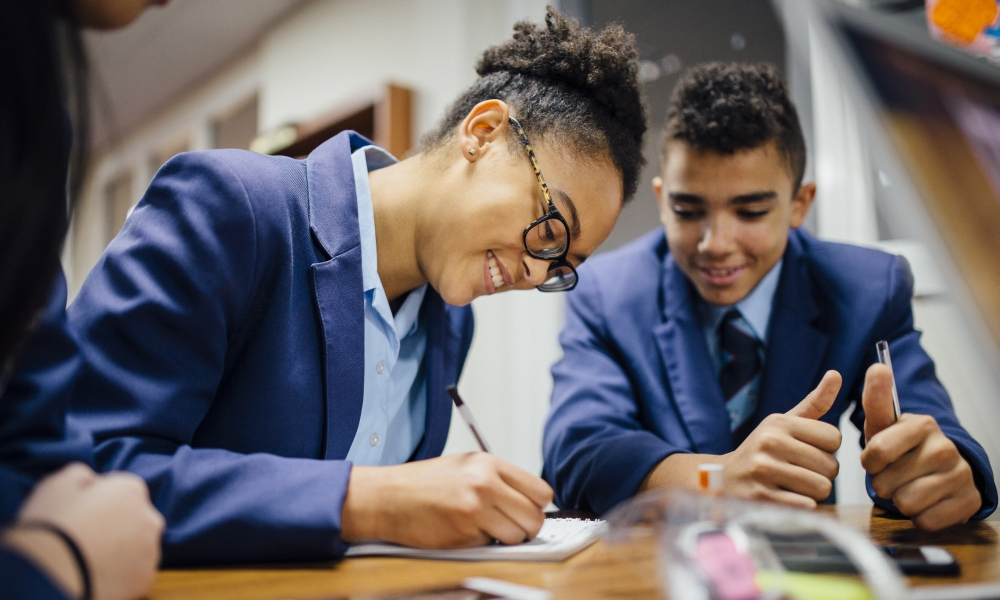Building a classroom where reading, writing and speaking are valued, and where stories are shared, is hardly simple work.
The Habits of Mind, developed by Arthur L Costa and Bena Kallick, focus on 16 habits or dispositions that help with life's challenges and education (Costa & Kallick, 2008; Costa & Kallick, 2009). By applying them in the areas of English and literacy, we invite our students to become fully engaged in their learning in a way they may have never imagined.
One of us has already written about the Habits of Mind in a variety of ways, including in language learning (Mason, 2019), but here we turn our attention as a united effort to the field of literacy.
The following discussion addresses each of the 16 habits and ways that we can use these with students as they learn about literacy and language.
Persisting
A key ingredient in the literacy classroom is a commitment to telling one's story. Finding the right tools to do that work, through reading and using words and pictures, is a powerful echo to the idea of persisting. Our classrooms are spaces of encouragement and revision as we improve our reading, writing, and speaking. After all, no writer was born forming perfect letters and plots. As teachers, we can normalise progress by discussing our own experiences of persistence and by being transparent about the ways we have learned and grown.
Managing impulsivity
Rather than take the standard classroom approach to managing impulsivity as a behaviour concern, we see the potential in this Habit of Mind for resisting the urge to jump to simplistic conclusions. In practice, this ‘jump' may sound like: ‘This is not the right book for me' or ‘I know all of that story already', or it may even be ‘I'm just not a reader'. There is always more story to be told, and we find our own challenge in recognising the power of all narratives and the importance of the work that authors do. We can also recognise that reader identity is shaped over time.
Listening to others with understanding and empathy
Literacy classrooms are not silent places, and are not spaces for stories to be silenced, either. It is through dialogue that we become better learners and thinkers. In our literacy classrooms, we envision room for healthy discussions and active work that takes place in the whole group, as well as in small groups.
Thinking flexibly
If there is nothing else that being an educator has taught us through the COVID-19 pandemic, it is that we must take a flexible approach to student learning. This is no less true when it comes to considering the resources students have in terms of their digital literacy, as well as in traditional print literacy. We become better readers as we move through experiences of success, starting with books that we find comfort in, and moving to more complex reading. These reading experiences build on a framework of strength rather than deficit allows teachers to flexibly respond to help students grow. This flexible response is especially important as the second language knowledge a student brings can be regarded as a strength to maximise, rather than a deficit to undermine.
Thinking about thinking (metacognition)
How many of us have reached the end of a passage and realised we weren't attending to meaning at all, but were distracted by other thoughts? Within the practice of metacognition as a Habit of Mind, we see an essential reading skill. This is invisible work, and it is complicated – but one way that teachers can model metacognition is in reading aloud and holding discussions.
Striving for accuracy
What's that word again? In the world of Lois Lowry's dystopian novel The Giver, students are swatted when they speak imprecisely. We do not envision that enactment of precision, but rather see a continuum of getting better, more in line with a growth mindset approach. This is yet another place where revision is powerful work.
Thinking and communicating with precision
‘Can you say that again?', ‘Can you tell us more?' Teachers can consider encouraging ways that are inviting and positive to allow students more opportunities to think and share. This is a progressive effort in written language, but also another reminder that our classrooms cannot be silent at all times.
Questioning and posing problems
Part of being an effective educator in any content area is knowing the value of a powerful and well-placed question. In literacy instruction, the ‘problems' we encounter are often found in the choices authors make in conveying meaning, sometimes relying on us to make inferences based on the breadcrumbs they provide. Graphic novels and comic books provide one avenue for making inferences with words and pictures, but this is a developed skill of posing questions, thinking about the decisions authors make in storytelling, and then dealing with the problem-solving steps of carrying authorly work into students' own writing.
Applying past knowledge
When we learn, we build upon past learning. For language and literacy, this means we can use vocabulary in a new essay that we write. We can use a grammar structure in speaking or writing. We can learn from our past mistakes and improve our current usage of English.
Gathering sensory data
Using various senses in combination makes us more engaged and able to learn. How can you reinforce language through your senses? Recite forms, vocabulary definitions and written documents out loud to get auditory feedback. Use colours, shapes and written language to stimulate visual learning. Imagine taste and smell when reading about foods or aromas of a specific locale. Gain insights through touch, such as imagining what it feels like to be in the locale of a novel or what the weather feels like in a short story.
Creating, imagining, and innovating
Encourage students to think of how awesome the English language can be by writing creatively, crafting poems and using their imagination to speak or write with a fantasy mindset. You can use a simple prompt, such as: ‘When speaking or writing, how can you phrase things differently to be creative and innovative?'
Responding with wonderment and awe
Read texts, watch films and write in a novel way so that you can bring wonder and awe to yourself or others through language and literacy. This sense of wonder begins with the teacher as a model, questioning and thinking aloud, and then becomes part of the experience students take up when responding to texts.
Taking responsible risks
Encourage students to try reading challenging texts, rethinking a written assignment or a new technological program that enables them to stretch their mind and skills. As a teacher, get them to consider your own ideas (and those of their classmates) for areas of expansion in language and literacy.
Finding humour
We often can alleviate stress by encouraging humour in our lives. Thinking about this in terms of a literacy-focused classroom: In what ways do we make mistakes with our spoken or written language or with listening or reading comprehension? How can we remember future exposure and practice of language through humour?
Thinking interdependently
Having students interact with classmates and not only with their teacher encourages cooperative learning. Pairs and small groups, as well as whole class brainstorming, can foster students' ability to work on language and literacy in a collaborative way. Consider interviews, peer editing, task-based group activities and a designated student editor (i.e., a student who is tasked with providing constructive feedback and positive take-aways) when planning lessons.
Continuous learning
Life presents numerous opportunities for continuous language. We can read fiction and non-fiction written materials, watch videos including films, attend stage plays or musicals and pursue education in traditional or digital ways. For the teacher, this might mean taking a linguistics course, writing poetry or reading complex works – again, modeling the behaviour of continuous learning that we hope to see students take up.
Further discussion
As English and literacy professionals, we can introduce the 16 Habits of Mind to students in several ways. Consider the following:
- Provide students with an overview of the general Habits of Mind;
- Post them in your classroom and provide a handout or digital summary;
- Incorporate them into lesson plans and use them during classroom activities;
- Have students focus on one or more habits when completing an assignment; and,
- Consider using the habits as part of your assessment tasks and activities.
References
Costa, A. L. & B. Kallick. (2008). Learning and leading with habits of mind: 16 essential characteristics for success. ASCD.
Costa, A. L. & B. Kallick. (2009). Habits of mind across the curriculum: Practical and creative strategies for teachers. ASCD.
Mason, K. (2019). 16 habits of mind: Fostering successful language learning. Teachers Matter Magazine 43, 30-31.
Think about an upcoming lesson or topic. With a colleague, consider the 16 habits and choose just one. How can you incorporate this into your lesson planning? How can you encourage students to focus on this when completing an assessment task?


